
Vintage Audio Inc. manufactures audio speakers. Each speaker requires $115 per unit of direct materials. The speaker manufacturing assembly cell includes the following estimated costs for the period: Speaker assembly cell, estimated costs: Labor $48,710 Depreciation 6,530 Supplies 2,380 Power 1,780 Total cell costs for the period $59,400 The operating plan calls for 165 operating hours for the period. Each speaker requires 15 minutes of cell process time. The unit selling price for each speaker is $312. During the period, the following transactions occurred: Purchased materials to produce 750 speaker units. Applied conversion costs to production of 715 speaker units. Completed and transferred 685 speaker units to finished goods. Sold 655 speaker units. There were no inventories at the beginning of the period. a. Journalize the summary transactions (1)-(4) for the period. Round the per unit cost to the nearest cent and use in subsequent computations. If an amount box does not require an entry, leave it blank. 1. 2. 3. 4. Sale 4. Cost

Answers: 1


Another question on Business

Business, 21.06.2019 17:00
The typical consumer's food basket in the base year 2015 is as follows: 30 chickens at $4 each 10 hams at $5 each 10 steaks at $8 each a chicken feed shortage causes the price of chickens to rise to $5.00 each in the year 2016. hams rise to $7.00 each, and the price of steaks is unchanged. a. calculate the change in the "cost-of-eating" index between 2015 and 2016. year cost of the basket 2015 $ 2016 $ instructions: enter your responses rounded to one decimal place. the official cost-of-eating index has by %. b. suppose that consumers are completely indifferent between two chickens and one ham. for this example, how large is the substitution bias in the official "cost-of-eating" index? the in the cost-of-eating index is %. the of inflation in the cost of eating reflects substitution bias.
Answers: 3

Business, 21.06.2019 21:30
Gary becker's controversial the economics of discrimination concludes that price discrimination has no effect on final profits. price discrimination benefits monopolies. labor discrimination in hiring results in more efficient allocations of production. discrimination in hiring practices has no effect on final profits. labor discrimination harms firms that practice it due to increased labor costs. price discrimination harms monopolies, which refutes over two centuries of economic theory.
Answers: 3

Business, 22.06.2019 08:30
Blank is the internal operation that arranges information resources to support business performance and outcomes
Answers: 2

Business, 22.06.2019 09:30
Factors like the unemployment rate, the stock market, global trade, economic policy, and the economic situation of other countries have no influence on the financial status of individuals. question 1 options: true false
Answers: 1
You know the right answer?
Vintage Audio Inc. manufactures audio speakers. Each speaker requires $115 per unit of direct materi...
Questions

Mathematics, 17.06.2020 06:57

Mathematics, 17.06.2020 06:57




English, 17.06.2020 06:57



Biology, 17.06.2020 06:57



Social Studies, 17.06.2020 06:57

Computers and Technology, 17.06.2020 06:57

Mathematics, 17.06.2020 06:57


Mathematics, 17.06.2020 06:57

Mathematics, 17.06.2020 06:57


English, 17.06.2020 06:57

Mathematics, 17.06.2020 06:57





